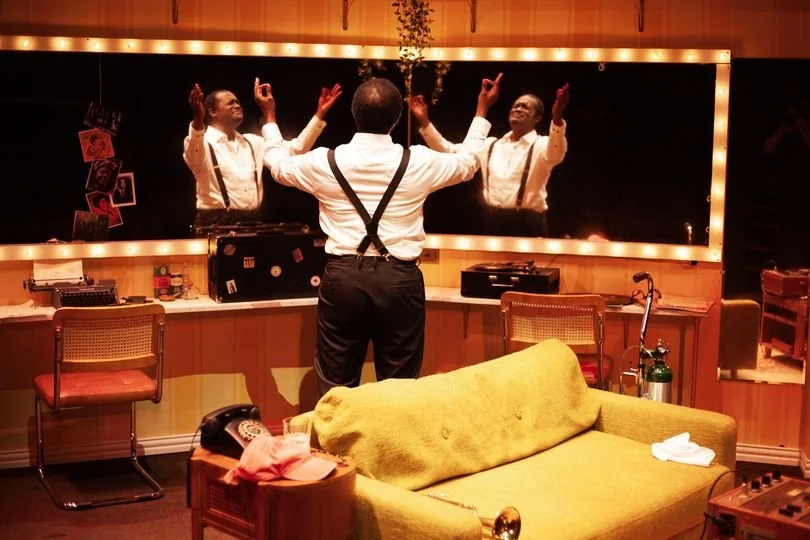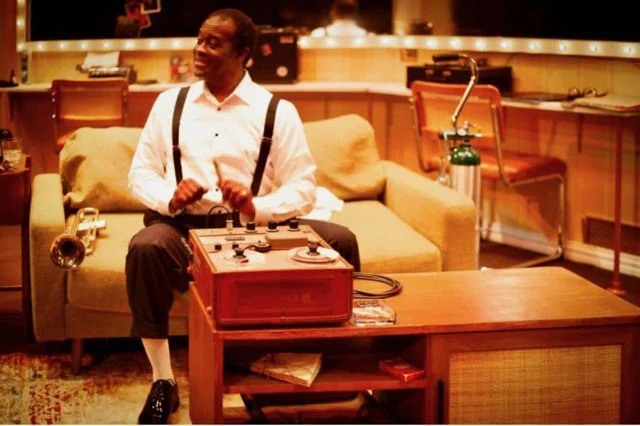‘Satchmo at the Waldorf’ @ WaterTower Theatre
Show photos by Paris Marie Productions
—Jan Farrington
WaterTower Theatre's engaging Satchmo at the Waldorf shows us a really good time--and that would have pleased the legendary Louis Armstrong, who never stopped trying to put smiles on the faces of the audience in front of him. In decades of music making, from the 1920s to the 1970s, "Satchmo" (the nickname started as "Satchel Mouth" for his signature wide-open grin) this kid from New Orleans dazzled audiences with his trumpet playing, enchanted them with an unlikely singing voice made of grit and gravel, and livened up a string of movies, crossing over from all-Black features (Pennies From Heaven, Cabin in the Sky) to Technicolor musicals (The Glenn Miller Story, High Society). For the younger generations, he may be best-known as the voice of the song "What a Wonderful World" in Madagascar.
I think Louis (it was Lou-iss, by the way, not the Frenchified Lou-ee) would have been happy with that as a closing number.
In Terry Teachout's play, the incredibly talented Sam Henderson plays Armstrong and two other men in his life: longtime manager Joe Glaser and another music legend, Miles Davis--who had some strong opinions about Satchmo and his smile. Too much "clowning," Davis said, though he liked the man himself. Bebop jazz musicians of the '50s thought Armstrong's style hadn't kept up with the changing times—though Dizzy Gillespie once tellingly commented, "No him, no me."
This is the older Satchmo—"Pops"—a tired gent hobbling in at the end of a performance and heading straight for the oxygen tank waiting beside the sofa. (The time is 1971, and Armstrong would die later that year.) A solid, square reel-to-reel tape recorder sits on the coffee table--and between talking to us, and talking to it, he swings into a series of memories and observations--not organized, but as old men remember, going from one story to another.
With director Feleceia Wilson and Henderson pulling together for this regional premiere of the play, it adds up to lots of fun, and plenty of firsthand information about how life was for a Black man--celebrated or not--back in the first half of America's 20th century. Armstrong's mother May Ann, a prostitute who loved but couldn't care for him, gave him up to a waif's home for "colored" boys in NOLA. He earned pennies running errands for a Jewish family who fed him dinner when he worked late (perhaps the start of his affection for manager Glaser, who took care of Louis—and his money).
Henderson is a fine fit for the roles he plays, moving easily from Armstrong's raspy voice to Miles Davis' quietly intense tones, and to a darned good Chicago accent for the Midwestern Jewish hustler Joe Glaser, whose friends, in classic Windy City fashion, were wise guys with ice in their veins and dollar signs in their eyes. The body language shifts in a flash: we can tell Armstrong's feet and back hurt; Davis's stillness is a mirror of the sense of restraint and containment we find in his music; and Glaser is a bit of a whirlwind, words and hands moving fast.
Late in his roaming life, Louis and his fourth wife Lucille settled down in the Waldorf for what we'd now call a "residency"—an extended run at the famous Empire Room. Kae Styron's backstage set, with its super-wide lighted makeup mirror anchoring the room, is a marvelously cozy and detailed space. All the comforts of home for Satchmo, and a mirror studded with newspaper clips, photos with Lucille (the only dark-skinned Black dancer at the Cotton Club when they met, he lovingly called her "Brown Sugar"), and a row of framed shots of all the stars that had headlined at the Waldorf before him. Quite a who's who, and Armstrong's photo would "be in that number" within a few months.
Terry Teachout was a much-admired theater critic for the Wall Street Journal, and wrote a biography of Armstrong that forms the basis of Satchmo at the Waldorf. One of the best things about the play is that Teachout leaves us room to think about these characters, and about the complicated threads of our history weaving their way through the story.
It's a surprisingly active experience that will keep you busy asking yourself questions, and balancing this and that, all the way home. Was Armstrong's smile and hanky a "sell-out"--or was there room in the Civil Rights era for a goodwill ambassador who "just" made people happy? Were Davis, Gillespie and the other cerebral jazz legends of those years on the right track, moving away from more people-friendly strains of jazz and swing--or did they lead jazz down a street audiences didn't like the looks of? Are performers always called to step forward for social justice, come what may--or can they change minds and open doors from within?
Louis Armstrong was a Black man who had to survive a lot of bumps, bruises, and spirit-battering experiences. He was also a loving, happy soul with a gift for spreading that around. Sam Henderson gives us all of that, and more, in Satchmo at the Waldorf.
It's a pleasure to meet you, Pops.
WHEN: April 17-28, 2024
WHERE: WaterTower Theatre, Addison TX
WEB: watertowertheatre.org



